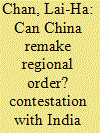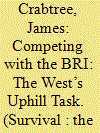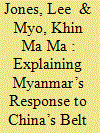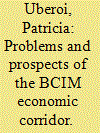| Srl | Item |
| 1 |
ID:
177634


|
|
|
| 2 |
ID:
177640


|
|
|
| 3 |
ID:
177639


|
|
|
| 4 |
ID:
172159


|
|
|
|
|
| Summary/Abstract |
This article argues that China’s Belt and Road Initiative (BRI) can be understood via the lens of regional ordering, whereby China attempts to redefine the shared goals and values for the region of Eurasia and to socialise regional states into the new values in order to have their consent to its leadership. The success of this strategy would then depend, to a large extent, on how its target regional audience reacts to the order-remaking strategy and practices. Taking an ‘eye of the beholder’ perspective, this article focuses on Indian perceptions of China’s order-remaking strategy in South Asia. It posits that India uses the ‘debt trap diplomacy’ narrative to delegitimise China’s infrastructure investment activities based on state capitalism, which have been perceived as a move to upend the status quo and challenge New Delhi’s traditional leadership in the region. To counter China’s growing influence, India is networking with other like-minded countries to promote a ‘free and open Indo-Pacific’ through groupings such as the Asia-Africa Growth Corridor, the Quad, Malabar exercises, and increasing political and economic bonds with the ASEAN countries. A serious contest over order between China and India in the Indian Ocean is looming on the horizon.
|
|
|
|
|
|
|
|
|
|
|
|
|
|
|
|
| 5 |
ID:
160082


|
|
|
|
|
| Summary/Abstract |
This article examines the geopolitical and economic implications of the Belt and Road Initiative for the Middle East. It locates the BRI within the region’s politics and examines the opportunities that the initiative offers for the region, as well as its inherent risks and challenges. It argues that the BRI is not merely an economic project as framed by Beijing, but that it represents a new stage in China’s engagement with the region, and—if fully implemented—could have wide geopolitical implications. The Middle East has the potential to contribute immensely to China’s sustained growth by addressing its energy security, supporting China’s role as a ‘megatrader’, and, more importantly, driving China’s efforts to become a global maritime power and monetary power by internationalizing the Renminbi (RMB). Thus, the BRI could have wide implications for the Middle East. Far from being a win-win project for all, the BRI will likely benefit some countries in the region more than others. Iran stands ready to benefit most. The BRI will likely increase the strategic importance of the Suez Canal and could potentially undermine the importance of some logistic hubs in the Middle East in favour of other trade hubs in Central Asia.
|
|
|
|
|
|
|
|
|
|
|
|
|
|
|
|
| 6 |
ID:
179825


|
|
|
|
|
| Summary/Abstract |
The West’s Build Back Better World Partnership will be hard-pressed to compete effectively with China’s Belt and Road Initiative.
|
|
|
|
|
|
|
|
|
|
|
|
|
|
|
|
| 7 |
ID:
177636


|
|
|
| 8 |
ID:
181318


|
|
|
|
|
| Summary/Abstract |
This paper examines China’s Belt and Road Initiative as an exercise in geocultural power. To date, Belt and Road has been analysed as a geopolitical and geo-economic initiative, with arguments constructed around the development of infrastructure, trade or finance agreements. This paper introduces the Silk Roads as one of the most compelling geocultural concepts of the modern era to show its strategic value as a platform for cooperation and multi-sector connectivity. A critical analysis of the Silk Roads provides new insights into Belt and Road, revealing how China is mobilising its geocultural potential as a civilisational state to build regional and continental connectivities.
|
|
|
|
|
|
|
|
|
|
|
|
|
|
|
|
| 9 |
ID:
166793


|
|
|
| 10 |
ID:
193424


|
|
|
| 11 |
ID:
177641


|
|
|
| 12 |
ID:
177635


|
|
|
| 13 |
ID:
143291


|
|
|
|
|
| Summary/Abstract |
This article takes a critical look at the new Chinese ‘One Belt, One Road’ (OBOR) or ‘Belt and Road Initiative’ (BRI) for 21st century Eurasian connectivity and economic integration from the perspective of the proposed Bangladesh–China–India–Myanmar Economic Corridor (BCIM-EC). The BCIM-EC is a sub-regional cooperation project that aims to link the land-locked provinces of southwest China with eastern India and the Bay of Bengal through northern Myanmar, India’s northeast region, and Bangladesh. However, within months of being mooted in May 2013, the BCIM-EC was yoked to another connectivity initiative, the China–Pakistan Economic Corridor (CPEC), and the two encompassed within President Xi Jinping’s grand vision for a new overland and maritime Silk Road. As of now, India has (i) endorsed the BCIM-EC, (ii) rejected the CPEC and (iii) maintained studied silence on the OBOR initiative per se. Where does that conundrum leave the BCIM-EC? And to what extent, if at all, can India leverage OBOR to its own advantage?
|
|
|
|
|
|
|
|
|
|
|
|
|
|
|
|
| 14 |
ID:
178748


|
|
|
|
|
| Summary/Abstract |
China’s Belt and Road Initiative (BRI) evolved from promotion of Eurasian connectivity into a catchall for Chinese foreign policy and infrastructure investments worldwide. Although usually portrayed as a top-down geopolitical project of the Chinese central government, this article argues the BRI is actually shaped by converging and diverging interests of a wide variety of actors within and outside China. In order to conceptualize the relational, contingent, and unstable emergence of the BRI in Latin America, the article emphasizes the process of co-production as a theoretical framework. It first analyzes how the BRI incorporated Latin America through policy and discourse analysis, then examines the multi-scalar and multi-sited co-production of Chinese-funded port and railroad infrastructures through interviews and public documents in Brazil.
|
|
|
|
|
|
|
|
|
|
|
|
|
|
|
|
| 15 |
ID:
177638


|
|
|
| 16 |
ID:
170697


|
|
|
|
|
| Summary/Abstract |
This article examines Cambodia’s backing of China’s Belt and Road Initiative (BRI). Having explored bilateral historical ties, the author concludes that Cambodia has pursued a bandwagoning policy with China for most of its post-colonial period since 1953. At present, Cambodia’s bandwagoning policy with China has been manifested in the former’s support of the latter’s initiative. It begs a question as to why the kingdom has enthusiastically supported it. The article elucidates the motives behind Cambodia’s bandwagoning policy on BRI applying John Spanier’s three level of analytical framework. First, on the systemic level, it argues that China’s bid to expand its influence, the change of balance of power in Southeast Asia, and the clean competition for influence between China and Japan in the Mekong Region have affected Cambodia’s policy decision on the BRI. Second, at the nation-state level of analysis, Cambodia perceives BRI as another funding source of infrastructure projects, and a means to achieve its policy goal of becoming an economic hub in the region and to whip up domestic support of the ruling party. Finally, on the decision-making level, the backing of the BRI may stem from Prime Minister Hun Sen’s pragmatic views of how to sustain his rule over the country. He might have viewed that economic growth would help to strengthen his ruling. The analysis concludes by identifying some negative repercussions Cambodia has encountered as a result of her support of the BRI.
|
|
|
|
|
|
|
|
|
|
|
|
|
|
|
|